
The Arctiinae are a large and diverse subfamily of moths with around 11,000 species found all over the world, including 6,000 neotropical species. This subfamily includes the groups commonly known as tiger moths, which usually have bright colours, footmen, which are usually much drabber, lichen moths, and wasp moths. Many species have "hairy" caterpillars that are popularly known as woolly bears or woolly worms. The scientific name Arctiinae refers to this hairiness. Some species within the Arctiinae have the word "tussock"' in their common names because they have been misidentified as members of the Lymantriinae subfamily based on the characteristics of the larvae.

Tirumala limniace, the blue tiger, is a butterfly found in South Asia, and Southeast Asia that belongs to the brush-footed butterfly family, Nymphalidae. More specifically it is part of the crows and tigers or danaid group. This butterfly shows gregarious migratory behaviour in southern India. In some places, it may be found in congregations with Danaus genutia, Tirumala septentrionis, Euploea sylvester, Euploea core, Parantica aglea, and at high elevations, with Parantica nilgiriensis, on Crotalaria.

Dryocampa rubicunda, the rosy maple moth, is a small North American moth in the family Saturniidae, also known as the great silk moths. It was first described by Johan Christian Fabricius in 1793. The species is known for its wooly body and pink and yellow coloration, which varies from cream or white to bright pink or yellow. Males have bushier antennae than females, which allow them to sense female pheromones for mating.
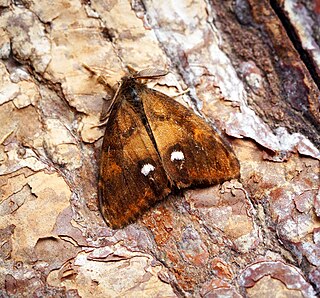
Orgyia antiqua, the rusty tussock moth or vapourer, is a moth in the family Erebidae.

Euchaetes egle, the milkweed tiger moth or milkweed tussock moth, is a moth in the family Erebidae and the tribe Arctiini, the tiger moths. The species was first described by Dru Drury in 1773. It is a common mid- through late summer feeder on milkweeds and dogbane. Like most species in this family, it has chemical defenses it acquires from its host plants, in this case, cardiac glycosides. These are retained in adults and deter bats, and presumably other predators, from feeding on them. Only very high cardiac glycoside concentrations deterred bats as predators. Adults indicate their unpalatability to bats with ultrasonic clicks from their tymbal organs.

Halysidota tessellaris, also called the pale tiger moth, banded tussock moth, and tessellated halisidota, is in the family Erebidae and the tribe Arctiini, the tiger moths. The species was first described by James Edward Smith in 1797. Like many related species, adult moths have chemical defenses acquired from its host plants, in this case, alkaloids. Larval behaviors suggest that they are chemically protected; they have not been analyzed for alkaloid content.
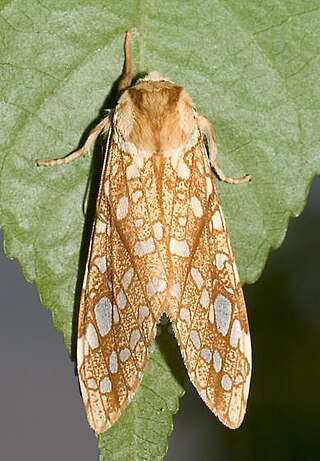
Lophocampa caryae, the hickory tiger moth, hickory tussock moth, or hickory halisidota, is a moth in the family Erebidae and the tribe Arctiini, the tiger moths. The species is widely distributed in the eastern half of North America. In other species in this family, the caterpillars acquire chemical defenses from their host plants, so they are potentially toxic or unpalatable, but despite anecdotal claims that this species may also be venomous, no venom has yet been isolated or identified; adverse reactions are characterized as contact dermatitis.

Orgyia leucostigma, the white-marked tussock moth, is a moth in the family Erebidae. The species was first described by James Edward Smith in 1797. The caterpillar is very common especially in late summer in eastern North America, extending as far west as Texas, California, and Alberta.

Acronicta americana, the American dagger moth, is a moth of the family Noctuidae. It was originally described by Thaddeus William Harris in 1841 and is native to North America.

Lophocampa is a genus of moths in the family Erebidae. The genus was erected by Thaddeus William Harris in 1841. It contains around 75 species.

Halysidota harrisii, the sycamore tiger moth, is a moth of the family Erebidae and the tribe Arctiini, the tiger moths. The species was first described by Benjamin Dann Walsh in 1864. It is found in southeastern Canada, the eastern parts of the United States, and northeastern Mexico.

Metacrias strategica is a species of moth in the family Erebidae. This species is endemic to New Zealand where it is known from the southern part of the South Island. The female of the species is flightless and pale brown, grey or yellowish-brown in colour where as the male is brightly coloured and flies during the day.
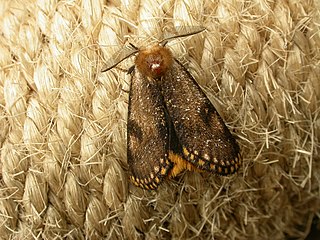
Epicoma contristis, the yellow-spotted epicoma, is a moth of the family Notodontidae first described by Jacob Hübner in 1823. It is known from Australia, including Tasmania, New South Wales and Victoria.

Orgyia thyellina, the white-spotted tussock moth, is a species of moth of the subfamily Lymantriinae first described by Arthur Gardiner Butler in 1881. It is native to the Russian Far East, Japan, Korea, Taiwan, and China. It was discovered in Auckland, New Zealand, in 1996. Operation Ever Green was established that same year to eradicate the pest. By 1998, the species was eradicated. It is thought of as one of the most successful eradication programmes ever undertaken in an urban area.

Lymantria dispar dispar or LDD moth, commonly known as the gypsy moth, European gypsy moth, North American gypsy moth, or spongy moth, is a species of moth in the family Erebidae that is of Eurasian origin. It has a range that extends over Europe, Africa, and North America.
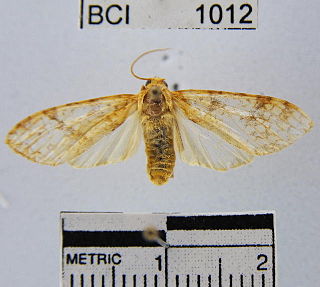
Lophocampa catenulata is a moth of the family Erebidae. It was described by Jacob Hübner in 1812. It is found on Cuba and in Mexico, Costa Rica, Guatemala, Panama, Venezuela, Suriname, French Guiana, Brazil, Peru and Argentina.
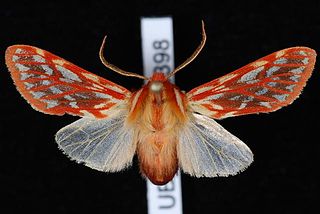
Lophocampa roseata, the rosy aemilia, is a moth of the subfamily Arctiinae. It was described by Francis Walker in 1868. It is found in North America in western Oregon, Washington and southwestern British Columbia. The habitat consists of conifer forests and urban landscapes.
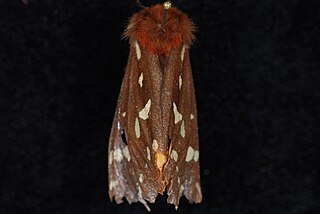
Arctia parthenos, the St. Lawrence tiger moth, is a moth in the family Erebidae. It was described by Thaddeus William Harris in 1850. It is found in boreal North America, ranging from Alaska to Labrador, south to New Mexico and Arizona in the Rocky Mountains and to North Carolina in the Appalachian Mountains. The habitat consists of riparian areas and mixed hardwood-conifer forests at middle to high elevations.




















